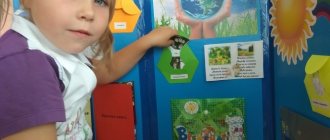Theoretical aspects of environmental education in preschool educational institutions
We are all children of one ship called Earth, which means there is simply nowhere to transfer from it... There is a firm rule: get up in the morning, wash your face, put yourself in order - and immediately put your planet in order.
Antoine de Saint-Exupery
https://ekolog17.jimdo.com/
The basics of environmental education have been included in programs for preschool institutions since the 60s of the last century. But if then the main emphasis was on instilling in children the basic fundamentals of environmental literacy, now - on the formation of an environmental culture from early childhood.
This position is reflected in the “Program of Education and Training in Kindergarten,” which formulates two main tasks:
- nurturing a love for the nature of the native land, the ability to understand and feel its beauty, to treat plants and animals with care;
- creating conditions for students to obtain basic knowledge about nature and forming in them a number of ideas about the phenomena of living and inanimate nature.
Preschoolers, due to the characteristics of their age, very organically perceive all knowledge that is associated with nature. After all, young children feel like they are part of nature; they have not yet developed a consumer attitude towards it. Therefore, the main task is to ensure that the feeling of an inextricable connection with the outside world, which arose in early childhood, remains for life.
A child in preschool age feels like a part of nature, and the teacher’s task is to strengthen this connection
Forms of ecology classes
Various forms of teaching are used in ecology classes. Main activities:
- Specially prepared classes. Here the teacher plays the main role. It can be:
- excursions,
- conversations with the teacher about nature, animals, plants,
- reading fiction,
- stories about the peculiarities of caring for animals.
- Joint activities of preschoolers and the teacher. Children take an active part in everything that happens in class. These include:
- various themed games,
- quizzes,
- drawing and design,
- observation,
- answers to children's questions,
- discussion of books read, filmstrips and cartoons watched,
- work in a living area,
- preparation of environmental holidays, etc.
- Independent work of children. Application of environmental knowledge acquired by preschoolers in practice. For example, they can independently (but under the supervision of a teacher) water flowers, feed animals in a living area, collect herbariums or collections.
Environmental education begins with children caring for plants and animals
Didactic and visual materials for ecology classes
Preparation for ecology classes in kindergarten involves the widespread use of a variety of didactic and visual materials. Moreover, some of them can be prepared together with children. So, in the preparatory and senior groups you can prepare visual aids for kids. For example, in design classes in the middle group, children can make visual material on the topic “Vegetable garden.” Only at the beginning of the lesson should they be warned that their crafts will be used as visual material for the kids. It is very important! Children (and people in general) love when their work is needed by someone and not wasted.
A visual aid on the topic “Vegetable Garden”, made by preschoolers of the middle group, will delight the youngest pupils of the preschool educational institution
At the beginning of classes, you can watch filmstrips and cartoons (“Red Cat”, “Locomotive from Romashkov”, “Treasure”, “Butterfly”, “The Tale of the White Ice”, “On the Forest Path”, “Shapoklyak”), and then discuss what you watched . So, using the example of the cartoon “Treasure,” you can discuss the meaning and value of ordinary drinking water, and after watching the cartoon “The Engine from Romashkov,” you can talk about how important it is to stop from time to time and observe nature and enjoy the amazing world around you.
Looking at pictures and paintings is one of the techniques used in the classroom. In the first and second younger groups, simple pictures depicting plants, animals, vegetables, and fruits are used. In the middle, senior and preparatory groups, you can look at reproductions of paintings by famous artists (“The Rooks Have Arrived” by A. Savrasov, “Morning in a Pine Forest” by I. Shishkin, “Beetle” by I. Kabakov, “Golden Autumn” by I. Levitan) and ask the children tell what they see on them.
Ecological lotto allows you to generalize children's ideas about various types of plants and animals
Games can also be used in environmental education classes, both tabletop (for example, various lotto games, “Find a Pair,” “Where Who Lives,” “Tops and Roots”) and mobile games (for example, “Saving Tree,” “Gnomes in the forest”, “At the Zoo” and the favorite nursery rhyme “The deer has a big house”). Posters, models, diagrams, nature calendars designed for ecological and living areas, exhibitions of drawings, and nature rooms can be used as teaching materials and aids.
The ecological corner in the preschool educational institution should be colorfully decorated and attract the attention of children
Video: nursery rhyme “The deer has a big house”
Goals and objectives of environmental education at school
Fostering an environmental culture is, from a pedagogical point of view, a very difficult process. Pedagogy says that education is the transfer of experience from older generations to younger ones. But the problem is that the environmental experience of the older generation is not enough to fully transfer it to schoolchildren (not only in our country, but throughout the world). In essence, here the student is a subject who must influence his elders and peers.
In elementary school, the goals of environmental education include:
- formation of a careful attitude towards the environment;
- compliance with the moral principles of relationships with nature, the use of its resources;
- propaganda of his ideas;
- active in the study and protection of nature
The main tasks of environmental education in primary school are almost the same as in preschool educational institutions, but in addition to the three main types, new tasks are identified, see Table 2.
Environmental education classes for preschoolers
Table 2. Objectives of environmental education in primary school
| Educational and educational | Deepen and expand environmental knowledge |
| Behavioral | Instill basic environmental skills and abilities |
| Cognitive | To develop cognitive, creative and social activity of students in the process of environmental activities |
| Transformative | Foster feelings of respect for nature |
Environmental education programs
There are 2 types of programs for preschool institutions: comprehensive and partial. Comprehensive programs prescribe actions aimed at the development of preschoolers in all areas, while partial ones examine in depth one or more thematically related areas.
Comprehensive programs
The most complete environmental aspects are provided for in the “Childhood”, “Rainbow” and “Krokha” programs. They have special sections devoted not just to obtaining basic knowledge about nature, but about the relationship between the world around us and humans.
“Krokha” is dedicated to the development of very young children, so the tasks here are simple: to contemplate, observe, learn. According to this program, it is recommended to set up a living corner in preschool institutions. Visiting it is especially useful for those children whose parents do not allow them to have animals at home.
The “Childhood” part of the program “A child discovers the world of nature” includes 4 blocks that take into account the age characteristics of children:
- information about plants and animals as representatives of living things in the natural world (features of external structure and vital functions, the connection of living beings with their environment, their uniqueness);
- mechanisms of adaptive relationships between living organisms and their environment (properties of different environments, ideas about groups of animals living in a homogeneous environment);
- knowledge about the growth, development and reproduction of plants and animals familiar to children (ideas about successive changes in organisms, the cyclical nature of the process);
- knowledge of an ecosystem nature (children get acquainted with plants and animals living in the same community and their interconnectedness).
The “Natural World” section of the “Rainbow” program provides for the study of the ecosystem of different regions of the world, geographical concepts, historical and archaeological facts. Its disadvantage is that children receive many interesting facts about the world, but do not learn to comprehend them. The “Origins” program has a section on studying the surrounding world, but it does not meet modern requirements, and the “Development” program does not generally set the goal of environmental education for preschool students.
A living corner in a preschool educational institution allows children to join the world of wildlife and care for pets
Partial programs
Partial programs for environmental education of preschool children approved by the Ministry of Education of Russia include:
- "Our home is nature"
- "Young ecologist"
- "Life around us"
- "Nature and the Artist"
- "Semitsvetik"
- "Cobweb"
- "We are earthlings"
- "Open yourself"
- "Hope".
Each of these programs is interesting in its own way, so each teaching staff has the opportunity to choose, depending on its own conditions.
The first programs for environmental education in kindergartens, which began to be developed back in the 90s of the last century, include “Young Ecologist”. Its author is S. Nikolaeva. It is worth clarifying that the “Young Ecologist” includes 2 programs: environmental education of children and advanced training for teachers. In this way, the complex task of educating the beginnings of environmental literacy in children and increasing the environmental culture of adults who are called upon to educate these children is solved.
Since environmental education is given great importance, preschool teachers throughout the country are developing their own programs based on their capabilities, geographic location and social conditions. The following programs are worthy of attention:
- “Enduring Values of the Small Motherland”, developed by teacher from Ivanov E.V. Pchelintseva;
- “I am in a big world”, created by a teaching team from the city of Seversk;
- “The ABC of Ecology” by L.I. Grekova (section of the “Planet of Childhood” program applied in the Stavropol Territory).
Effective environmental education through play activities
Problems of environmental education are touched upon in the works of N.V. Kolomina, V.P. Goroshenko. The most effective and interesting forms of working with preschool children are discussed in the works of S.N. Nikolaeva. The author emphasizes that games not only give children the opportunity to have fun, they contribute to their comprehensive development.
During the game, children are given freedom of action, they feel relaxed, and have the opportunity to take the initiative. Games can be played with the participation of fairy-tale characters, who make the atmosphere less scientific and more lively and memorable.
What is deviant behavior of preschool children
Preschool educational institutions use story games, workshops on making toys, illustration games, board games, and didactic games. Their goal is not only entertainment. Children develop humane feelings, a desire to help animals or plants, and to solve a problematic situation.
How to conduct a lesson on ecology in kindergarten
Environmental education programs provide a wide variety of forms of activities with children, from games to serious projects.
Ecological trail
One of the most fun forms of outdoor environmental activities is the nature trail. In every kindergarten it is desirable to have 3 types of paths and use them according to age groups. The first path is located in the premises of the preschool educational institution; it may include specially designed stands, a nature room, and a living corner. The second one runs through the territory of the preschool institution and is used during daily walks. And the third path is for travel. She leads the children to the area adjacent to the garden. It could be a square, a park, a forested area, a meadow, or even a real forest.
An ecological trail is a specially equipped route along which preschoolers acquire knowledge about the natural environment.
Ideally, along the entire route along the trail, children should encounter both wild and cultivated plants growing separately and crowded together, various trees and shrubs, birds living in nests, trees or specially equipped houses, anthills, stones, ponds... In In general, the more varied the better. Of course, you need to create your own route for each age group. It is advisable to draw up a plan for the ecological trail and place it at the beginning of the route. While traveling along the ecological trail, children listen to the stories of the teacher, observe, ask questions, learn to draw conclusions, collect herbariums, collections, etc.
Project activities on ecology in kindergarten
In the process of environmental education in kindergarten, special attention should be paid to the research activities of children. The development of various projects, which can be both short-term and long-term, can help with this. Short-term projects are more common in preschools. Their topics can be different, for example, “Communicating with animals”, “What is the power of water”, “From ear to loaf”, “Who spends the winter in the forest”, etc.
Encouraging children's research interests develops their thinking abilities and stimulates further cognitive activity
However, long-term projects are also within the capabilities of preschool children. You should pay attention to the following topics: “Feed the birds”, “We planted a turnip”, “Vegetable garden on the windowsill”, “Aquarium - the kingdom of fish”, “Let’s grow a lemon”, etc.
The development of both short-term and long-term projects requires a lot of effort, preliminary preparation, study of materials and literature on the topic, observations, research and the ability to draw conclusions. It is also important to beautifully design and present your project in a captivating way. Children will have to learn all this.
The “Mushroom” applique is made by children as part of the “Hello, Autumn!” project.
Example of a project for the second junior group
| Name | "Hello, autumn!" |
| Tasks |
|
| Materials |
|
| Activities of the teacher |
|
| Parents' activities |
|
| Activities during the project implementation |
|
| Project outcome |
|
You can learn more about conducting ecology classes in the first and second junior groups from our article - Features of environmental education in junior groups.
Sample lesson plan on the topic “How bread is made” in the middle group
Purpose of the lesson: to demonstrate to children how bread is made.
Equipment and materials:
- Pictures,
- sprouted wheat,
- green wheat sprouts,
- wheat grains and spikelets,
- pieces of bread,
- flour,
- eggs,
- salt,
- yeast,
- water,
- vegetable oil.
Progress of the lesson:
- Children watch the cartoon "Spikelet".
- The teacher invites the children to find out where wheat grains live, how wheat grows, how flour is made, how bread is baked.
- Children look at sprouted wheat and wheat sprouts.
- The teacher invites the children to take the spikelets and find the grains in them.
- The teacher invites the children to find out what is tastier - grains, flour or bread. Children try grains, flour and pieces of bread.
- The guys are asked whether they know how delicious bread is made.
- Then the teacher kneads the dough from the prepared products, explaining the process to the children.
- Children watch how the dough rises.
- The teacher and the children make buns and take them to the kitchen.
- While the buns are baking, the teacher tells how grain farmers grow wheat and harvest, and the children look at the pictures.
- The cook brings the baked rolls and everyone tries them.
Video: cartoon “Spikelet”
Lesson in the second junior group on the topic: “Making a hedgehog”
Take “Travyanchik” toys in the shape of a hedgehog. First, children water toys, grow grass, and at the same time learn how, why and under what conditions grass grows. The teacher also tells them about hedgehogs - where they live, what they eat, how they winter. When the grass grows large enough, a lesson on how to design “Trim the Hedgehog” is taught. Before starting the lesson, you can watch a cartoon about hedgehogs, for example, “Should a hedgehog be prickly?”
When making a hedgehog from the “Travyanchik”, children get cute crafts, and they treat the pets of the living corner with the remains of the grass
Then the children use scissors to trim their grass plants. The cut grass is taken to a living corner and treated to the pets living there.
Conducting open events on environmental topics
Ecology classes provide a wide opportunity to conduct a variety of open events. Parents' participation is welcome here. Moreover, they can not only attend matinees and watch their children perform, but also take an active part themselves. Parents can help build and hang houses and bird feeders, participate in joint excursions along an ecological trail, organize picnics for children together with teachers, take part in World Car Free Day, etc.
It is possible to generalize and consolidate children’s knowledge about living and inanimate nature in the form of an environmental quiz, KVN, brain-ring, etc., held together with parents.
Examples of notes for conducting open classes on ecology in different groups
- Belyakina E. “The Tale of Water” (second junior group).
- Savina A. “Journey to the spring forest” (middle group).
- Nashirvanova R. “Our friends are trees” (senior group).
- Polivakhina G. “Be a friend of nature” (preparatory group).
Video: open lesson “Visiting the Dwarf” in the second junior group
Video: open lesson “Sowing seeds” in the preparatory group
If you choose the most exciting activities for preschoolers in a preschool educational institution, then the environmental direction is beyond competition, given that this component can be introduced into any educational activity. Children are inquisitive, they love everything related to research, and the world around them acts as a fascinating subject for study. All that remains is to form the right attitude towards it. This is the main task of kindergarten teachers when implementing environmental education.




